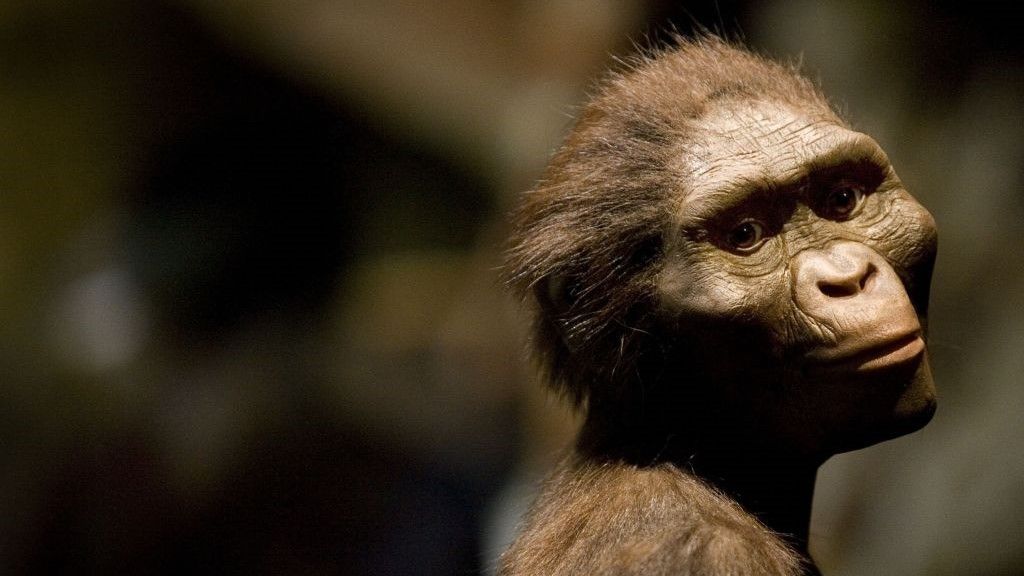A sculptor’s rendering of the hominid Australopithecus afarensis in an exhibition that included the 3.2 million-year-old fossilized remains of “Lucy.” (Image credit: Dave Einsel via Getty Images)
Our 3.2 million-year-old ancestor “Lucy” could stand and walk upright just like modern humans do, new 3D muscle modeling reveals.
The finding bolsters a growing consensus among researchers that Australopithecus afarensis — the extinct species to which Lucy belongs — walked erect rather than with a chimpanzee-like, crouching waddle.
The hominin’s reconstructed pelvis and leg muscles also suggest that she could climb trees, meaning the species likely thrived in both forest and grassland habitats in East Africa 3 million to 4 million years ago.
“Lucy’s muscles suggest that she was as proficient at bipedalism as we are, while possibly also being at home in the trees,” Ashleigh Wiseman, a research associate at the University of Cambridge’s McDonald Institute for Archaeological Research in the U.K. who conducted the modeling study, said in a statement. “She would have been able to exploit both habitats effectively.”
Lucy’s fossils are the best-preserved Australopithecus remains ever unearthed, with 40% of her skeleton recovered from Ethiopia’s Hadar region in the mid-1970s. Her bones indicate that she stood 3.4 feet (1 meter) tall and weighed between 29 and 93 pounds (13 to 42 kilograms). Her discovery pointed to the possibility that human ancestors could walk upright long before they evolved bigger brains.
Related: Human ancestor ‘Lucy’ gets a new face in stunning reconstruction
While soft tissue is not visible in the fossil record, scientists can piece together what the extinct species’ muscles may have looked like by using modern humans (Homo sapiens) as analogs. Our bone structure and muscle attachments can inform how muscles were layered on Lucy’s skeleton.
In a study published Wednesday (June 14) in the journal Royal Society Open Science, Wiseman used a digital modeling approach to recreate 36 muscles in each of Lucy’s legs.
Wiseman used scans from modern humans as a reference to layer muscles onto a virtual model of Lucy’s skeleton. (Image credit: Dr Ashleigh Wiseman)
The reconstruction shows that Lucy could straighten her knee joints and extend her hips in a similar way to modern humans, suggesting that the species could stand and walk upright.
The model also reveals the proportions of fat and muscle in Lucy’s legs, showing they were far more muscular than a modern human’s and similar in composition to a bonobo’s (Pan paniscus). While a human thigh is about 50% muscle, Lucy’s were likely 74% and less fatty. Some of her calf and thigh muscles occupied twice as much space in her legs as they do in human legs today.
Lucy’s knees demonstrated a wider range of motion in the extension-flexion axis than a human’s. This, combined with her muscle mass, suggests that A. afarensis could utilize a wide range of habitats, from dense forests to grassy savannas. This type of locomotion is not seen in any modern animal, Wiseman said. “Lucy likely walked and moved in a way that we do not see in any living species today.”
While the finding is based on an incomplete skeleton, and it remains unknown how often A. afarensis adopted an upright posture, the results of the analysis support the current consensus of Lucy’s physical abilities.
The model revealed that Lucy’s legs were far more muscular than a modern human’s and more similar in composition to a bonobo’s. (Image credit: Dr Ashleigh Wiseman)
“The current paper is not a game changer in our thinking,” said Fred Spoor, a professor and researcher at the Natural History Museum in the U.K., who was not involved in the research.
However, reconstructing the muscles is a novel and exciting method to confirm bipedalism, Spoor told Live Science in an email. “This approach is certainly promising,” he said. “It goes beyond the sometimes somewhat simplistic interpretations of paleontologists when it comes to inferring what movements and locomotor pattern characterized an extinct species.”
Muscle modeling has already helped researchers gauge the walking speed of a Tyrannosaurus rex and could shed light on similar traits in archaic humans. “By applying similar techniques to ancestral humans, we want to reveal the spectrum of physical movement that propelled our evolution,” Wiseman said.
































